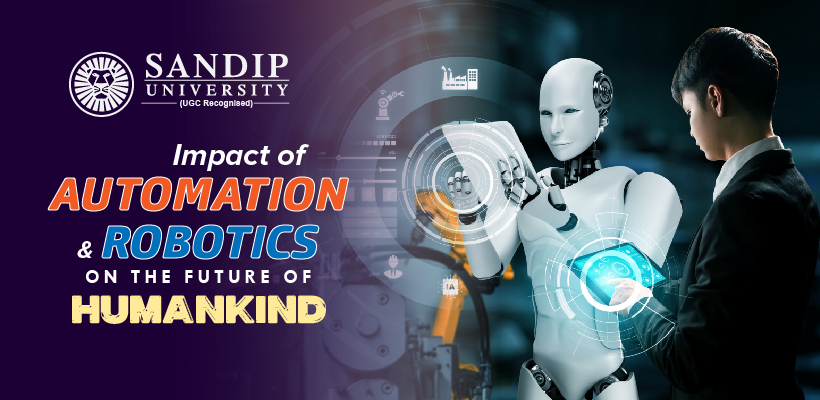In the past few decades, automation and robotics have evolved from the pages of science fiction to become essential components of modern life. The rise of robots, powered by cutting-edge automation technology, is shaping industries, improving efficiency, and even influencing how we interact with the world. Many top engineering colleges in Maharashtra offer globally-recognised programs in AI and robotics to train future engineers. As we march into the future, the integration of automation and robotics is building a new reality—one where robots play a vital role in everything from manufacturing to healthcare, agriculture, and beyond.
The Dawn of Automation
Automation, in its simplest form, is the use of technology to perform tasks with minimal human intervention. It began with the mechanisation of factories during the Industrial Revolution, when machines started taking over repetitive and labour-intensive tasks. Fast forward to the 21st century, and automation has become far more sophisticated. Now, it encompasses everything from simple assembly line robots to complex artificial intelligence systems capable of making decisions based on vast amounts of data.
Industries such as manufacturing, logistics, and transportation have already seen massive improvements in efficiency and productivity through automation. For instance, automated systems in warehouses can sort and pack items faster than humans, while self-driving vehicles are poised to revolutionise logistics by reducing the need for human drivers. In essence, automation is enhancing productivity and reducing costs across various sectors, paving the way for the next wave of innovation.
Robotics: The Physical Embodiment of Automation
While automation provides the brains, robotics provides the brawn. Robots are the physical agents that carry out automated tasks, and their capabilities are expanding at an astonishing rate. Early robots were confined to repetitive tasks in controlled environments, such as assembly lines in car factories. But today, robots are becoming more versatile, adaptive, and autonomous.
Robots now exist that can carry out jobs requiring strength, delicacy, and precision thanks to advancements in robotics. For example, doctors can now do complex procedures with more accuracy thanks to surgical robots than they could with just human hands. In order to ensure food security and sustainability, farmers are using autonomous drones and robots to monitor crops, apply fertiliser, and even harvest vegetables. Furthermore, robots are not just used in industrial settings.
The employment of service robots in household, hospitality, and healthcare settings is becoming more and more common. Robots are becoming more and more ingrained in our daily lives, doing everything from delivering meals in restaurants to helping the elderly with everyday activities. Robots are becoming more and more common in many industries, which portends a time when they will be used everywhere.
Artificial Intelligence: The Brain Power behind Robotics
The fusion of artificial intelligence (AI) and robotics is a game-changer. AI equips robots with the ability to learn, adapt, and make decisions in complex environments. Unlike traditional robots, which follow pre-programmed instructions, AI-driven robots can analyse data, recognise patterns, and adjust their behaviour accordingly. For example, autonomous robots in warehouses use AI to navigate around obstacles and optimise their routes in real time. B.Tech in AI and ML can really help boost AI-powered robotics.
By evaluating patient data and medical imaging, AI-powered robots in the healthcare industry help physicians diagnose patients more accurately. Robots’ capacity to pick up knowledge from their surroundings and develop over time is creating new opportunities in a variety of industries. Robots should grow even more competent as artificial intelligence (AI) develops, allowing them to perform ever-more-complex activities that were previously believed to be the sole purview of humans.
The Impact on the Workforce
The possible effects on employment of automation and robotics are among the biggest worries. Many worry that human labour will be replaced by machines, resulting in mass unemployment. Automation will undoubtedly disrupt some industries, but technology advancements frequently lead to new business opportunities, as history has demonstrated. Humans may now concentrate on more creative and strategic work as robots take over dangerous and repetitive chores. Furthermore, the expansion of the robotics sector itself is creating new opportunities in programming, maintenance, robot design, and artificial intelligence development. Training and education will be essential in assisting the workforce in adjusting to this new reality.
Building the Future, One Robot at a Time
Robotics and automation have a bright future ahead of them. These technologies will become more and more important in reshaping industries, enhancing quality of life, and solving global issues as they develop. The possibilities are boundless, ranging from self-driving cars lowering traffic accidents to robots assisting in disaster recovery. But immense power also entails great responsibility. Robotics and automation systems must be developed and implemented with ethics in mind as we build the future. To make sure that everyone benefits from automation and robots, concerns like data privacy, security, and the possibility of bias in AI must be addressed.
Conclusion
Automation and robotics are building the future, one robot at a time. Our lives and our jobs are changing as a result of these technologies, bringing with them both new opportunities and difficulties. There are many leading best engineering colleges in Nashik that are committed towards research and development in automation and robotics. We can use automation and robotics to harness the potential of invention and work together to overcome obstacles in order to build a more promising future for everybody.

